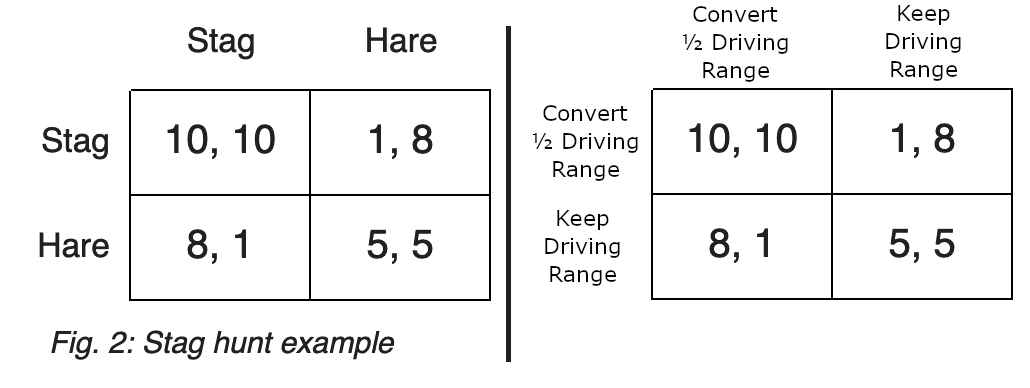Golf for Non-Golfers: Getting from Zero to Golf Should be Fun
Courting beginners means offering a playable game without expecting them to learn first and play later.
“Grow the Game”
It’s an idea I deeply support, even if I don’t care for the cliched phrase. I think the problem is that it’s vague. For some, it seems to be about making the game more accessible. For others it’s specifically focused around DEI issues.1 For many it’s about making golf more affordable.2 Some feel it is about increasing participation (even if the participation is simply golf media consumption).3 Others think the phrase is about growth at all costs.4
The phrase is so associated with golf marketing that I can’t stand to hear it anymore. Half the articles about it are so awful and obvious that I find myself shaking my head. Here are some suggestions offered by the PGA:
6. Embrace the youth.
7. Embrace the Millennials.
8. Celebrate and embrace diversity.5
If we’re really not following these obvious steps we have a deep cultural problem beyond just how unwelcoming we are to beginners.
Golf is fun. People will take up the game if we just let them play at their own skill level. The problem is that the way we’ve set it up, beginners can’t really do that. We throw people into the deep end instead of letting them wade in at their own pace. We force them to make a sizable commitment (both financial and cultural) up front. We expect them to go from the driving range to a full-scale 9- or 18-hole course with no steps in between. It’s no wonder the sport has trouble attracting, and keeping, new players.
Instead, we should offer a clear path that lets people play golf as they learn. It would keep people interested and invested in the sport. But first, let’s take a look at the steps new players are expected to complete in order to just get started.
How most people learn the game
Stage 1: Acquire a set of golf clubs
If you have someone who’ll loan you clubs, you’re already ahead of the curve. Renting clubs at a course is prohibitively expensive. Purchasing a used set at a thrift shop will require significant guidance. Buying a set new is a huge investment.
Stage 2: Go to a driving range
Next you will get to play practice golf. We seem to think starting at a driving range is normal and good. We’ve even built fancy driving ranges with lights and music so people aren’t entirely bored by practicing something they’ve never actually played.
This is how we introduce people to golf? Golf is supposed to be fun. Making people practice first won’t drive everyone away, but it’s not exactly inviting.
Stage 3(a): Pitch & Putt (if you’re lucky)
If you’re lucky to have a local pitch and putt, after a bit of practice, you can probably go have fun at one of these places. I know folks who have only really played pitch and putts, with no intention of taking the game seriously enough to move to full courses. This is the first stage of play, and it should be celebrated. Unfortunately, most American cities don’t have any short courses.
Stage 3(b): Go play at a beginners’ course.
Of the towns that have golf courses, most will have one course that is generally welcoming to beginners. Right now I think these courses are the most important places for beginners, because it’s where people learn to love playing. Unfortunately, beginners’ courses tend to be quite crowded, and there can be plenty of ruthless locals trying to squeeze in a four-hour round where they usually run eight-minute intervals. When this happens, the very places that welcome beginners can end up as hostile environments because of golf’s obsession with pace-of-play.
Taking a friend who has never played a round of golf before to even this type of course can be a struggle. I’ve found myself saying “Hey bud, I know it’s your first time, but you should probably just pick up because the group behind us is getting restless.” It’s not the hallmark of a welcoming game.
Beginners are just doing their best, trying to have a good time, and paying good money, but often get treated like they should apologize for even existing. It’s an unappealing onramp. It’s hard. It means beginners really need to be fixated on practice and can’t just be casually interested.
A better way of introducing beginners is to let them play at places that are specifically suited to their skill level.
A focus on entertainment yields a completely different approach
I look at this issue as though I’m concierge at a golf resort. My job is to make sure every single person who comes to the resort has a positive experience, no matter what level of exposure they have to the game. This is how I would pitch the sport and how I would get each person playing no matter their experience level.
Stage 0: Those folks look like they’re having a good time
If someone has never been exposed to golf, the goal should be to show them it’s a good time. This is where most of the other theories of growing golf focus. People who work on DEI issues focus here. Exciting media personalities help here. Getting people interested in golf is important to the onboarding process.
I think making the course’s restaurant/bar inviting to the general community can really help at this stage. I have written about this at some length, but suffice it to say, if we stop creating clubhouses as a refuge from the public, and instead make them inviting to the public, chances are the general public will have much more respect for and curiosity about the golf community.
This is an important place to start, but from my perspective, it can’t be the end: our goal can’t just be to get people excited enough about the sport that they’ll struggle through its demanding learning curve. I just want us to reduce the learning curve by adding stages for each skill level.
Stage 1: Putting clubs
Skills: 0-30 yards, putting stroke, green reading, speed and stopping the ball
The first thing I’d like to see more of already exists at St Andrews. The Old Course has visitors almost every day of the year, and while experienced players will stay up all night trying to snag a cancellation, most folks who visit don’t even play golf. These people without experience would still like to participate, and St Andrews has them covered.
The St Andrews Ladies' Putting Club is the home of The Himalayas. It is an 18-hole putting course that is as challenging as they come. The mounds you get to putt across are upwards of five feet high, and it takes a low handicap golfer to even attempt to finish the course under par, yet the course is still trivially accessible to anyone who just wants to try their hand at golf and have some fun. This course isn’t easy, but the point is that the skills required to execute a decent shot here don’t require training. People can have fun on day one.
Some other courses have followed in this tradition, notably The Punchbowl at Bandon, The Drumlin at Erin Hills, and Thistle Dhu at Pinehurst. However, these are destination courses, not places a beginner might stumble upon. They serve exactly the people who benefit the least from a lower bar to entry. The only locales I’ve heard of with putting courses for beginners are Aiken Golf Club in South Carolina and the Journeyman Distillery in Michigan, which isn’t even a golf course. I’ll admit there are probably more, but generally speaking, they don’t really exist, yet there should probably be one in every major city.
There will be folks who object here, saying the costs of operating putting courses far outweigh the benefits. Typically, putting courses are offered at little expense to players, however there are plenty of ways besides fees to reduce their costs. Putting courses need not be fancy and manicured to stimp at 13. In fact, large putting courses similar to the Himalayas could be entirely artificial turf (these courses are to serve beginners after all). With some genuinely thoughtful course design, along with food and beverages, communities could have an inviting and exciting way to make good money while giving novice adults and children their first step toward loving the links.
I must also note that it’s important to differentiate between miniature golf and a putting course. While miniature golf might teach players how to strike the ball, the wild undulation on the surface of a course like the Himalayas teaches players to read greens and understand speed.
Stage 2: Chipping courses
Skills: 35-65 yards, shot strength, ground game, the very basics of contact
The second step to welcoming people to golf also already exists in Scotland. The city of Edinburgh features the Bruntsfield Links in the middle of the city. It is a 36-hole, free, short course that welcomes everyone in the city all summer long. Shorter than a pitch and putt, most of these holes are between 40-65 yards. Arguably par 3s, but really they’d play about par 2 ½ for most skilled players. These courses typically feature small greens and short turf, allowing players to putt from distance.
I can say from personal experience that an afternoon at the Bruntsfield Links with a new player is an absolute delight. People could play the whole course with a putter if they chose to, but most will play best with a 9 iron, wedge, or chipper to get the ball running up to the tiny irregular greens. The greens here are kept very small, maybe a few paces in diameter, and aren’t mowed particularly short. There are no hazards. These types of courses can just be a fairway cut and maybe a bit of extra attention for the greens (if they are even cut shorter than the fairway at all).
The adjacent pub will rent out a wedge and putter for about £5.6 When I played, we would head to a thrift shop, pick up a couple of used clubs and a ball, and the novice would have enough equipment to play for almost nothing. After nine, 18, or even 36 holes, new players had genuine golf experience. When people can go out, spend a few dollars at a thrift shop and have clubs at home, they aren’t just learning golf – they are playing golf with clubs they own. They are already golfers after one round.
I also want to stress that these short courses are great fun for mid-to-low handicappers. It’s a different game, but the short-game skillset is still there. There will be stiff competition between all levels of play even if this type of course lends itself to a casual atmosphere.
Stage 3: Pitch & Putts
Skills: 65-100 yards, swing dynamics, good contact, pace of play, lofted shots
The pitch and putt is typically the first type of beginners’ course available to Americans. Popular pitch and putts include Los Feliz Par 3 course in Los Angeles, and Butler Pitch & Putt in Austin, but there are many around the States. These courses typically allow players to take full shots with sand and lob wedges into greens, but most will bump and run as they learn. The greens are usually full size.
Generally speaking, getting people onto a pitch and putt is an acceptable way to start, but if players already have skills built up from a short course, there will be less frustration as they learn to take full swings.
Stage 4: Par 3 Courses
Skills: 90-200 yards, full swings, recovery shots, wind effects, shot shaping
Here we arrive at the par 3 course. Cities that have a full par 3 course should count themselves lucky. They are usually the first real test of golf in a beginner-friendly environment. Players will truly need to take full swings, play from bunkers, deal with rough, and avoid water.
Beginners should feel welcome at most par 3 courses, but it can be challenging when these are places where people make their first real swings. Beginners would be better served by working up to these courses, than, say, starting their first round staring down a 164-yard hole, playing uphill, with a bunker short-right. Holes like that can be pretty intimidating, even for experienced players.
Making golf accessible means letting beginners enjoy themselves at their own pace, but economics can get in the way.
How do we maintain these beginner facilities?
Short course vs driving range: misaligned incentives
The incentives of golf course operations here are mostly to blame. Most people who live and work in the world of golf have little desire to dedicate a large part of their facility to something that the regulars won’t be particularly excited about. I often find myself shaking my head at the fact that one single golf hole could fit an entire nine-hole short course for beginners. You could trivially fit a massive putting course and a short course inside the area of your average driving range, but the question remains: which would you choose to install if you were a course manager?
Size comparison: range at Jimmy Clay GC vs the entire 36-hole Bruntsfield Links from the same height
This gets into game theory. The total value of dollar terms that increase the demand for golf would likely wildly outstrip the amount of revenue of a single driving range (I write this knowing the driving range is often a major source of revenue). The problem is that the value generated by creating an environment conducive to beginners would not be captured by the course that created it.
The type of scenario we are discussing here is a public goods game, but for the purposes of illustration, I will describe it as a stag hunt. Folks familiar with game theory will almost certainly recognize the stag hunt game.
Left: stag hunt game from Wikipedia | Right: same game with labels changed
To explain the game, we have two courses. One course could turn half its driving range into a large putting course, and the other could turn half its driving range into a short course. Either course could just keep the driving range as is. If they both change their layout to be inviting to beginners, they can bring more players into the game of golf, increasing revenue to everyone. If neither changes anything, the courses continue as they are. However, if one course courts beginners and the other doesn’t, the beginner-friendly course pays the costs, but splits the reward, and will lose money. It’s easy to see why a course would be very hesitant to court beginners. Here there are two equilibria that become clear: it’s great to cooperate, and it’s just fine to do nothing. But trying to court beginners alone is a very bad strategy.
What can be done? Coordination problems don’t have easy solutions.
The typical solution to any coordination problem is to use governmental structures to support optimal coordination. I think the USGA or PGA of America could do a lot here. Programs and incentives would help municipalities understand the importance of dedicating a piece of their land to the next generation. Cities could easily just mandate that their municipal courses court beginners, and distribute the land use between courses so that no one course has to host all the beginner facilities. Unfortunately, when courses build “beginner facilities” it typically takes the form of more driving ranges. Building another driving range can be marketed as being for beginners, but will likely be mostly consumed by advanced players.
When municipal courses need to show a high rate of existing use, investing in the future is challenging. Do I think it would be wise for a muni to convert its driving range to court beginners? Of course. But I certainly understand why they might not. The advantages that munis have are hard won, and it would be very unpopular at those clubs for the experienced golfers to give up their perks.
Rock Creek Park: a case study for a truly beginner-friendly facility
The proposed Rock Creek Park plan, in Washington DC, is really remarkable.7 It has nearly everything I’d like to see in a municipal golf facility. The National Links Trust plan has done well to propose a multi-use facility that should be a model for all courses moving forward. The proposed nine-hole site also has features that address many of the issues I bring up.
The location will have a large putting area. Some have called this a “Himalayas-style putting course,” and while I can’t find it in the plans, if the putting area does indeed have a putting course, it’s a huge step forward.8
Next, the location will also have a par 3 course. The proposed length is 1,205 yards, which leaves the average length at about 133 yards. Thus this exists fully as a par 3 course, and not as a pitch and putt, but it is still short enough for total beginners to play.
Both of these added features will serve beginners well, but we still see the two key stages of player development (stage 2 and stage 3) missing, and here we have committed to a very large (double decker) driving range that will continue the culture of learn-through-practice over learn-through-play.
If I were offered input on the site, I think I would propose that, between East Potomac, Langston, and Paint Branch, the amount of driving ranges in the District of Columbia is redundant. Since the plan for Rock Creek is to base the First Tee program at the facility, it makes perfect sense to have a large range for teaching programs. But with three other ranges in DC and no putting, chipping, or pitch and putt courses, converting one or two of the other driving ranges would make the game massively more accessible.
If municipal developments in other major cities follow Rock Creek Park’s example and expand on it, we could see a major uptick of interest in golf. Facilities that focus on play at every skill level, will always be in demand.
Update: I wanted to add a list of more chipping courses and putting courses as I learn about them:
Chipping Courses:
Holmby Park GC, Los Angeles, CA
Beall, Joel. “How an Internet letter turned into a $100000 grant for two Black golfers.” Golf Digest, 25 February 2021, https://www.golfdigest.com/story/maurice-allen-grow-the-game-2021. Accessed 20 June 2023.
Marksbury, Jessica. “This is the real key to growing the game, according to Dan Hicks.” GOLF.com, 29 September 2021, https://golf.com/news/real-key-to-growing-the-game-according-dan-hicks/. Accessed 20 June 2023.
Wright, Andrew. “New Female Celebrity Golf Series Aiming To Grow The Game.” Golf Monthly, 30 March 2021, https://www.golfmonthly.com/news/new-female-celebrity-golf-series-aiming-to-grow-the-game-225684. Accessed 20 June 2023.
Chamblee, Brandel. “Growing the Game: How Golf Gets it Wrong.” Golf Channel, 9 July 2015, https://www.golfchannel.com/article/brandel-chamblee/growing-game-how-golf-gets-wrong. Accessed 16 June 2023.
PGA of America. “10 ways to grow the game of golf right now.” PGA of America, 15 August 2018, https://www.pga.com/archive/golf-instruction/fast-tips/10-ways-grow-game-of-golf-right-now. Accessed 16 June 2023.
Ye Olde Golf Tavern. Short Hole Golf - Edinburgh, https://golftavern.co.uk/short-hole-golf/. Accessed 23 June 2023.
National Capital Planning Commission. “The Future of Rock Creek Park Golf — National Links Trust.” National Links Trust, January 2023, https://www.nationallinkstrust.org/future-of-rock-creek-golf. Accessed 18 June 2023.
Morrison, Garrett. “Rock Creek Park Gets a Plan.” The Fried Egg, The Fried Egg: Club TFE, 10 January 2023, https://thefriedegg.com/rock-creek-park-renovation-plan-club-tfe/. Accessed 18 June 2023.
Photo Credits:
PaulBR75. “Golf Clubs Bags Driving Range - Free photo on Pixabay.” Pixabay, https://pixabay.com/photos/golf-clubs-golf-bags-driving-range-1633748/. Accessed 20 June 2023.
St Andrews Ladies' Putting Club: Himalayas Putting, St Andrews, Scotland, https://www.standrewsputtingclub.com/. Accessed 20 June 2023.
Hogg, Mary, and Angus Hogg. “Pitch and putt.” Wikipedia, https://en.wikipedia.org/wiki/Pitch_and_putt#/media/File:Pitch_and_Putt_-_geograph.org.uk_-_819047.jpg. Accessed 20 June 2023.
National Capital Planning Commission. “The Future of Rock Creek Park Golf — National Links Trust.” National Links Trust, January 2023, https://www.nationallinkstrust.org/future-of-rock-creek-golf. Accessed 18 June 2023.










Great article, Matthew! I appreciate all the points made on stage 1 and 2, namely the emphasis on reading greens and speeds for stage 1 as well as the element of competition still being present at stage 2 regardless of skill level. Often times I hear playing partners (erroneously) refer to short game courses as "for babies" since they can't bust out driver.
Do you have any thoughts on a Stage 5: Newbie at Full Sized Course? Asking your playing partner(s) to pick up is no fun, even if it's the right thing to do. I've found that explicitly calling for Stableford or Quota format at the start of the round allows for a nice balance between maintaining pace of play and allowing everyone to play their own ball, while also not hurting too many feelings.